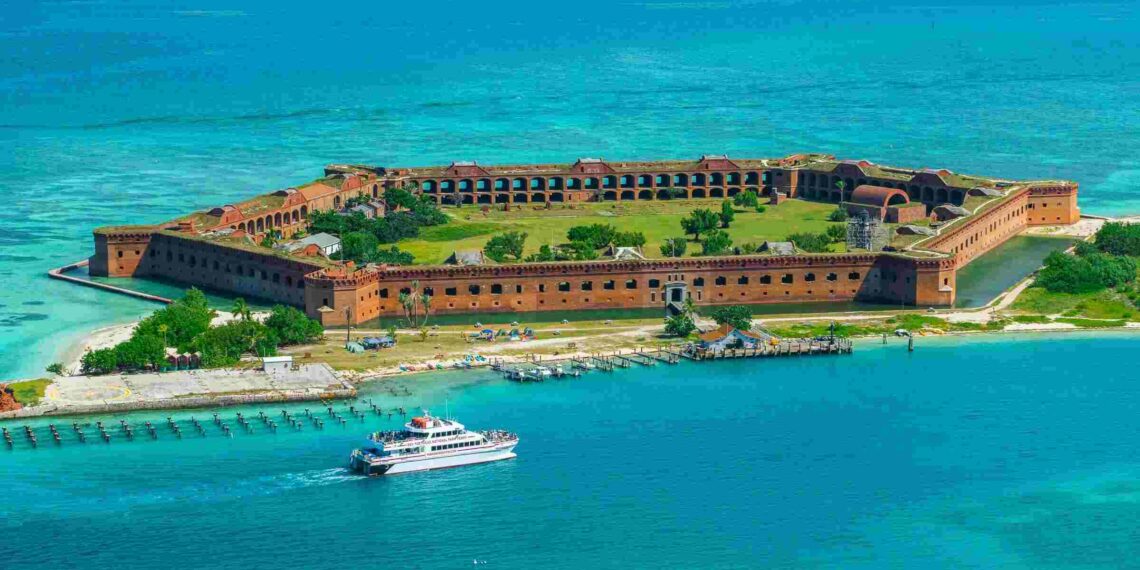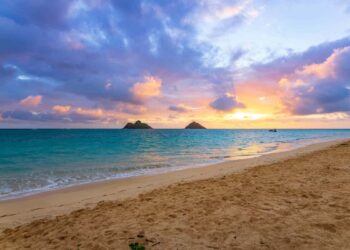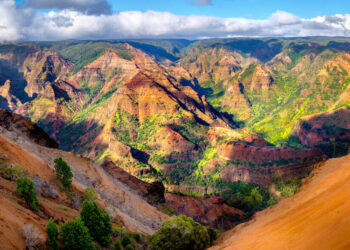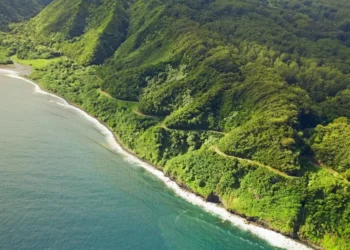Nestled seventy miles west of Key West, Florida, Dry Tortugas National Park emerges from the Gulf of Mexico like a whispered secret of the sea. This remote cluster of seven coral islands, surrounded by turquoise waters and fringed with reefs, offers a rare blend of natural splendor and historical weight. Fort Jefferson, a colossal brick hexagon dominating Garden Key, stands as a sentinel of America’s past—a relic of ambition and isolation. Beyond its walls, the park unfurls a marine wonderland, where snorkelers glide among shipwrecks and birds wheel above sands untouched by time. Here, the horizon stretches unbroken, inviting travelers to step into a realm where solitude and discovery reign.
Notable Insight: The park’s name, “Dry Tortugas,” stems from Spanish explorer Ponce de León, who, in 1513, dubbed it “Las Tortugas” for the abundance of sea turtles. The “Dry” was tacked on later—a nod to the absence of fresh water, a fact that shaped its rugged history.
Places to Visit: An Overview
Dry Tortugas National Park is a compact yet multifaceted destination, with each corner revealing distinct treasures. Garden Key, the park’s heart, hosts Fort Jefferson—an unfinished 19th-century fortress that sprawls over sixteen acres. Its weathered ramparts and echoing corridors tell tales of soldiers, prisoners, and storms. Beyond the fort, the island’s beaches shimmer with coral sand, perfect for quiet strolls or a dip into the shallows.
Loggerhead Key, the largest island, beckons with its lighthouse, erected in 1858 to guide ships through treacherous waters. Though closed to casual visitors, its silhouette against the sky adds a poetic note to the seascape. Bush Key, a shifting spit of sand, serves as a sanctuary for nesting seabirds—terns and frigatebirds painting the air with their cries. For underwater explorers, the park’s coral reefs and shipwrecks, like the Avanti sunk in 1907, offer a submerged gallery of marine life and history.
The surrounding waters, part of the park’s 100-square-mile expanse, teem with tropical fish, lobsters, and the occasional sea turtle gliding through. Whether you’re peering from a boat or submerged in a snorkel mask, the clarity of these depths unveils a living mosaic beneath the waves.
How to Reach
Reaching Dry Tortugas demands a touch of planning, as its isolation is both its charm and its challenge. No roads lead here—only water or air will carry you across the seventy-mile stretch from Key West.
Ferry Travel: The Yankee Freedom IV, a high-speed catamaran, departs daily from Key West’s Historic Seaport. The journey spans two hours and fifteen minutes each way, slicing through the Gulf’s swells with a promise of adventure. Departures occur at 8:00 a.m., returning by 5:30 p.m., and fares include park entry, breakfast, lunch, and snorkeling gear. Booking ahead is wise—spots fill quickly, especially in peak seasons like spring and early summer.
Seaplane Excursions: For a swifter, skyward approach, Key West Seaplane Adventures offers half-day or full-day flights. The 40-minute trip skims low over the water, revealing shipwrecks and reefs from above before landing beside Garden Key. Prices climb higher than the ferry, but the aerial perspective—and extra time on the islands—makes it a worthy splurge. Reservations are essential, as space is limited.
Private Vessels: Seasoned boaters can chart their own course, though the park’s remoteness requires preparation. Anchoring zones dot the harbor, and a permit is needed for overnight stays. Check weather forecasts—sudden squalls can churn these waters into a mariner’s test.
Experiencing the Park
Fort Jefferson’s Legacy: Step onto Garden Key, and the fort looms large—its red-brick walls rising from the sand like a mirage. Begun in 1846 to guard America’s Gulf frontier, it never saw battle but housed soldiers and, during the Civil War, Union deserters dubbed “Key West canaries.” Self-guided tours wind through its arches and gunrooms, where rusted cannons still point seaward. Climb the terreplein for a sweeping view—emerald waters clashing with the fort’s stern geometry.
Snorkeling and Reefs: The park’s underwater realm is its quiet star. Patch reefs near Garden Key shimmer with parrotfish and sergeant majors, while the Windjammer Wreck, a three-masted relic, rests in shallow depths off Loggerhead Key. Bring your own gear or use the ferry’s stash—either way, the sea’s clarity rewards every glance.
Birdwatching Haven: Bush Key’s avian spectacle peaks from spring to fall, when sooty terns and brown noddies nest in raucous colonies. Binoculars in hand, you’ll catch frigatebirds soaring with their forked tails, a sight unchanged since pirates prowled these shores.
Stargazing Serenity: With no city lights to compete, the night sky over Dry Tortugas blazes. Campers on Garden Key—permitted with advance registration—can lie back on the beach, tracing constellations as the Milky Way spills across the heavens.
Frequently Asked Questions About Dry Tortugas National Park
What’s the best time to visit?
Spring (March to May) offers mild weather and calm seas, ideal for snorkeling and ferry travel. Summer brings heat and humidity, plus a higher chance of storms—check forecasts closely. Winter can be breezy but less crowded.
Are there facilities on the islands?
Barely. Garden Key has composting toilets and a small visitor center with exhibits, but no food, water, or shade beyond the fort. Pack everything—water, snacks, sunscreen—as self-sufficiency is key.
Can you stay overnight?
Yes, with a catch. Primitive camping on Garden Key allows a handful of tents, first-come, first-served, via ferry bookings. Bring all supplies; the reward is a night under stars with only the waves for company.
Is it family-friendly?
Absolutely, though it suits active families. Kids love the fort’s nooks and snorkeling’s wonders, but the lack of amenities means parents must plan ahead—no strollers or snack bars here.
What wildlife should I expect?
Beyond birds and fish, look for green and loggerhead turtles, especially in summer nesting season. Nurse sharks patrol the shallows, harmless but thrilling to spot.
Beyond the Expected
Sunset Splendor: Time a late ferry return or seaplane departure for dusk, when the sun dips below the horizon, gilding Fort Jefferson’s silhouette. The sea mirrors the sky’s fire—a fleeting, unforgettable tableau.
Historical Echoes: The fort’s most famous inmate, Dr. Samuel Mudd, patched up John Wilkes Booth’s leg after Lincoln’s assassination. Imprisoned here in 1865, he earned a pardon by tending yellow fever victims—his cell a stark reminder of redemption’s cost.
Fun Fact: The Dry Tortugas once lured treasure hunters chasing Spanish galleons lost to reefs. In 1985, salvager Mel Fisher struck gold—literally—pulling $450 million in coins and artifacts from the nearby Atocha wreck, now housed in Key West’s museums.
Final Reflection
Dry Tortugas National Park is no mere stopover—it’s a pilgrimage to a place where nature and history collide with quiet force. Fort Jefferson’s bricks whisper of a nation’s reach, while the reefs and birds pulse with life older than memory. Standing on Garden Key, the world shrinks to wind, water, and the faint hum of what was. It’s a journey that demands effort—miles of sea to cross, provisions to haul—but rewards with a stillness that lingers. Here, amid the Gulf’s embrace, you touch something raw: a testament to endurance, a mirror to the wildness within us all.











